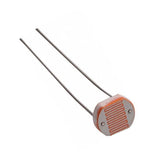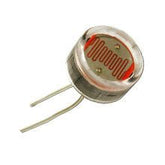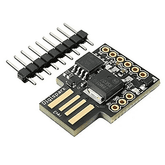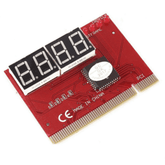How LDR Sensor Works
Summary
Explore the wonderful world of Light Sensors! Prepare to study the internal workings of LDRs. But what exactly is an LDR? Allow us to walk you through its intriguing nature and the mysteries of its function.
Discover the many LDR breeds and how to create your own LDR sensor module. Investigate its almost endless possibilities, including how it utilizes light to control and automate activities. This post explains all you need to know about these fascinating LDR sensors.
Introduction
A simple device that measures the amount of light present is the Light Dependent Resistor (LDR) Sensor.
LDRs function by reacting to various visible and infrared light wavelengths, and as ambient light intensity rises, so does their resistance.
The most popular type is an exposed semiconductor, typically made of silicon or germanium, that is covered in a plastic epoxy resin casing to help prevent damage from environmental changes like temperature swings or moisture seeping into other spaces that could contain sensitive electrical components.
When installed correctly, these sensors are capable of providing excellent accuracy when detecting changing lighting conditions within their operational range; they can also provide precise control over illumination for various applications, ranging from industrial automation tasks to entertainment systems.
This technology provides excellent dependability for a wide range of applications, both indoors and out, with the right calibration and maintenance!
Explore the Light Dependent Resistor sensor.
What is an LDR Sensor Module?
LDR full form Light Dependent Resistor is also known as a photoresistor, photocell, or photoconductor. LDR sensor module is a simple device that can be used to detect light levels and respond to light. When there's more light, its resistance goes down, and when there's less light, its resistance goes up.
In the dark, it has a very high resistance, sometimes up to 1 MΩ, but when the LDR sensor is exposed to light, the resistance drops drastically, to as low as a few ohms, depending on the light intensity.
The sensitivity of LDRs varies with the wavelength of the light applied and is are nonlinear device.
Find out what a Light Sensor is and why it's important.
How Does an LDR Sensor Module Work?

Light Dependent Resistor, or LDR is a transducer that senses light intensity and converts it into an electric current. It has two electrodes, one of which acts as the cathode while the other acts as the anode.
The resistance of LDR decreases when exposed to a certain level or amount of radiant energy, such as sunlight, artificial lights, etc., thus producing a small voltage proportional to the incident light intensity.
This property makes them suitable for use in applications like solar panel controllers, security systems, and variable lighting controls by changing their resistance value according to variations in ambient illumination conditions.
Moreover, they are cost-effective compared with traditional passive infrared motion sensors due to their low power consumption features, making them very popular among professionals from various industries, especially automotive, where these kinds of sensors play vital roles, immensely contributing towards safety assurance measures onboard any vehicle type, including cars & motorcycles alike!
Understanding photoconductivity is necessary in order to understand the operation of LDR sensors. The statement implies that a substance's conductivity reduces when light strikes its surface.
This is because the photons in the incoming light have more energy than the semiconductor material used in the LDR's band gap. Making the electrons jump from the valence band to the conduction.

These devices depend on the light; when light falls on the LDR then the resistance decreases, and the resistance increases in the dark.
From the previous explanations, it can be deduced that when an LDR light sensor is kept in a dark place, its resistance is high and when the LDR is kept in the light, its resistance will decrease.

Variation of LDR Resistance with Variation in Light Intensity:
If a constant “V’ is applied to the LDR, the intensity of the light increases, and the current increases.
The figure below shows the curve between resistance Vs illumination for a particular light-dependent resistor.
As per the property of LDRs, the amount of light entering the LDR is inversely proportional to the resistance of the sensor, and the graph is hyperbolic.

Know: How to design an LDR Circuit easily.
What is LDR used for?
Light Dependent Resistors are often used as light sensors. LDR sensor works when it is required to detect the presence and absence of light or to measure the light intensity.
Examples are night lights and photography light meters. An interesting hobbyist application for light-dependent resistors is the line following robot, which uses a light source and two or more LDRs to determine the needed change of course.
Sometimes, LDR sensors work in other sensing applications, for example, in audio compressors, because their reaction to light is not instantaneous, and so the function of the LDR is to introduce a delayed response.
Read our blog explaining how does an ldr work, provides comprehensive information about Light Dependent Resistors (LDRS), explaining their working principle, types, advantages, disadvantages, and applications.
How LDR Works in Street Lights?
These systems help in the efficient monitoring and control of solar-powered lights installed in remote locations. It's really hard to keep these lights working well, especially in places where there's no electricity.

This is where LDR sensor is working. By utilising radio communication, operators can check on solar lights from far away.
They can change settings and fix problems without going there, from adjusting brightness levels based on ambient light conditions or diagnosing technical faults. LDR light sensor makes it easier and cheaper to manage solar lights over long distances.
LDRs don't just make things easier, they also make places safer and more secure. They save energy in important areas where good lighting is really needed.
What are the types of LDR?
The classification of LDR can be done based on linearity or based on the photosensitive materials used in the LDR light sensor. The most frequently used materials while designing LDR mainly include cadmium sulfide, thallium sulfide, cadmium selenide & lead sulfide.
The classification based on the material is:
1. Intrinsic photoresistor:
These types of photoresistors are made with pure semiconductors without any doping. Pure semiconductor materials like germanium and silicon are used. When the incident light having an adequate amount of energy falls on this then electrons gain that energy and get excited, which leads to a few of them going to the conduction band.
2. Extrinsic Photoresistor:
These photoresistors are composed of doped semiconductors. It also indicates that the semiconductor and impurities such as phosphorus, are mixed to form the photoresistor.
Extrinsic light-dependent resistors commonly handle infrared (IR) and other longer wavelengths of light.
The classification based on the linearity is:
1. Liner type LDRs:
They are called photodiodes; however, in some application areas, this LDR works as photoresistors because of the linear performance they present & their operation.
2. Non-linear LDRs:
They are commonly used, but their behaviour does not depend on the polarity through which they unite.
LDR Sensor Module or Photoresistor Sensor Pin Diagram

LDR Sensor Module or Photoresistor Sensor Pin Diagram
LDR light sensor module is a low-cost digital sensor as well as an analogue sensor module, which is capable of measuring and detecting light intensity.
This sensor is also known as the Photoresistor sensor. This sensor has an onboard LDR (Light Dependent Resistor), which helps it to detect light. This sensor module comes with 4 terminals.
Where the “DO” pin indicates the digital output pin and the “AO” pin indicates the analogue output pin.
The output of the module goes high during the absence of light and it becomes low in the presence of light. The sensitivity of the sensor can be adjusted using the onboard potentiometer.
The VCC pin indicates the +5 v power supply Input Pin, and the GND indicates the ground (-) power supply Input Pin.
LDR Sensor Module or Photoresistor Sensor Hardware Overview
The LDR module mainly consists of the LDR, LM393 Comparators, a Variable Resistor (Trim pot), a Power LED, and an output LED.
1. LDR or Light Dependent Resistor
LDR or Light Dependent Resistor is one type of variable resistor. The features and functions have been previously discussed in detail.
2. Variable Resistor (Trim pot)
The LDR sensor module has an onboard variable resistor or potentiometer; this variable resistor has a 10k preset.
It is used to set the sensitivity of the LDR module. When the preset knob is rotated the sensitivity of the light intensity detection is varied.
Rotating the preset knob clockwise increases the sensitivity of the light intensity detector. Rotating the preset knob counterclockwise reduces the sensitivity of the light intensity detection.
3. Power LED
This onboard LED indicates if the power supply is ON or OFF. When we turn on the sensor power supply, this Green LED is also turned on.
4. Output LED
When the LDR detects the light, the green LED is activated. When the sensor detects darkness, the green LED is turned off.
How to make an LDR Sensor Module
The Components Required to build an Light Dependent Resistor sensor module are IC: LM358 or LM393 (You can choose any one of these ICs), LDR or Light Dependent Resistor (R2), two 1K Resistor (R1, R4), 10K Resistor (R3), 10K Potentiometer (VR1), two 0.1 uF Ceramic Capacitor (C1, C2) and two Green LED (D1, D2).
Connect the components as shown in the LDR circuit diagram to build an LDR light sensor module:
- +5 V power supply is taken
- 1K resistor is connected in series with the LED
- Capasitor C1 is connected in parallel to the above.
- PIN 2 is connected to a 10K Potentiometer VR1.
- The LDR, which is parallel to capacitor C2, is connected to PIN 3.
- The output DO is taken from PIN 1 of the IC.
- The output AO is taken from PIN 3 of the IC.
- Detection LED in series with a resistor R4 is also connected to PIN 1.

LDR Circuit Diagram
How to Use LDR Sensor Module
The Light Dependent Resistor sensor module has to be connected to a 5 V power supply.
Then the threshold voltage needs to be set at the Non-Inverting input (3) of the IC according to the present light intensity by rotating the preset knob for setting the sensor sensitivity.
When light intensity increases on the surface of the LDR, the resistance of the LDR decreases. Which means that the maximum amount of voltage will be allocated across the resistor(R3).
Therefore a Low amount of voltage from the LDR is given to the Inverting input (2) of the IC. The Comparator IC then compares this voltage to the threshold voltage. When the input voltage falls below the threshold value, the sensor output becomes LOW (0).
On the other hand, as the light intensity on the LDR's surface drops (low/dark), its resistance rises.
Then the maximum amount of voltage will be allocated across the LDR (R2). Therefore, a High amount of voltage from the LDR is given to the Inverting input (2) of the IC.
Then the Comparator IC compares this voltage with the threshold voltage. In this condition, this input voltage is greater than the threshold voltage, so the sensor output goes High (1).
Application of LDR Sensor:
LDR light sensor modules are used where there is a need to sense the presence or absence of light is necessary.
These resistors are used as light sensors, and the applications of LDR mainly include alarm clocks, street lights, light intensity meters, and burglar alarm circuits.
Nowadays, the lighting of highways is done through HID or LED lamps, but the energy consumption of these lights is high as well, and there is no particular mechanism to turn on/off the lights from sunrise to sunset, other than it being done manually.
To overcome this problem, an alternative method can be the power conservation of intensity-controlled street lights using LDR.
Uses of the LDR sensor
Because of their versatility, light-dependent resistors, or LDRs, are widely employed in a wide range of applications. Key applications for LDRs include:
- Security Systems: Photo proximity switches and laser-based security systems make extensive use of LDRs. This is an excellent illustration of how light-detection reflectors (LDRs) are used to enhance security protocols by detecting changes in the environment.
- Automatic Lights: LDRs are widely used in energy-efficient lighting systems, such as those with automatic lights that switch on and off in response to ambient light levels.
- Smoke detectors: Light-dependent resistors (LDRs), are designed to detect differences in the quantity of light generated by smoke and then sound an alarm or activate warning systems in response. This is a great example of how LDR technology may help save lives.
- Optical Circuit Design: The design of optical circuits demonstrates the flexibility of LDRs in electronics as they are useful in the creation of a wide range of electronic devices and systems that employ light-based processes.
- Solar-powered street lamps: These essential lights automatically change their brightness according to the amount of daylight available. They provide an example of how LDRs are used in environmentally friendly and energy-efficient systems.
Conclusion
In this blog article, we learned that Light Dependent Resistors (LDRs) play important functions in a variety of electronic applications, including lighting, photography, and security systems.
The LDR sensor's function is simple yet effective, which allows it to detect light levels and activate events based on ambient lighting conditions.
With an understanding of LDRs, one may select the best one for their project requirements.
If you appreciate our work and understand working of LDR sensor don't forget to share this post and leave your opinion in the comment box.
Please do check out other blog posts about Popular electronics
Make sure you check out our wide range of products and collections (we offer some exciting deals!)












